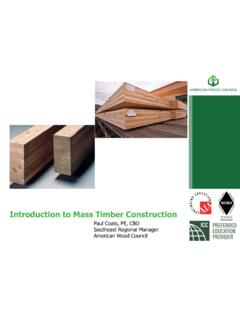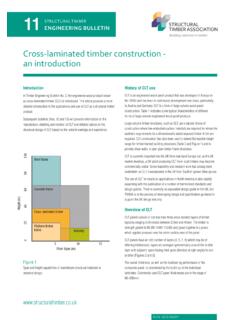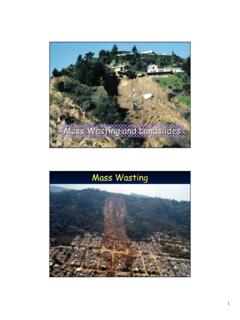Transcription of Construction Types - Definitions - Treated Wood
1 Construction Types - Definitions TYPE I: Fire-Resistive Walls, partitions, columns, floors and roofs are noncombustible. Designed to withstand the effects of fire for a limited time and prevent fire spread. Made of poured concrete and steel. Steel members must have a fire protective 1 structures are high-rises; defined as buildings more than 75 feet tall, with some agencies making amendments for buildings that are 35 55 feet tall. Type 1 structures are constructed of concrete and protected steel (steel coated with a fire resistant material, most often a concrete mixture), and are designed to hold fire for an extended amount of time in order to keep the fire at bay in the room and/or floor of I-A--Fire Resistive Non-combustible(Commonly found in high-rise buildings and Group I occupancies).
2 3 Hr. Exterior Walls* 3 Hr. Structural Frame 2 Hr. Floor/Ceiling Assembly 1 Hr. Roof ProtectionTYPE I-B--Fire Resistive Non-Combustible(Commonly found in mid-rise office & Group R buildings). 2 Hr. Exterior Walls* 2 Hr. Structural Frame 2 Hr. Ceiling/Floor Separation 1 Hr. Ceiling/Roof AssemblyTYPE II: Non-Combustible Walls, partitions, columns, floors and roofs are noncombustible but provide less fire resistance. Does not withstand the effects of fire or fire spread. Noncombustible refers to the fuel the building contributes, not its resistance to spread of fire. Typically exposed metal floor and roof system and metal or masonry walls. Least stable in terms of collapse, when exposed to II Construction is typically found in new buildings and remodels of commercial structures.
3 The walls and roofs are constructed of non-combustible II-A--Protected Non-Combustible(Commonly found in newer school buildings). 1 Hr. Exterior Walls 1 Hr. Structural Frame 1 Hr. Floor/Ceiling/Roof ProtectionTYPE II-B--Unprotected Non-Combustible(Most common type of non-combustible Construction used in commercial buildings). Building constructed of non-combustible materials but these materials have no fire resistance. Technical BulletinConstruction Types - Definitions Pg. 1 TYPE III: Ordinary Walls of masonry or other noncombustible walls with a 2 hour fire rating. Floors, roofs and interior partitions are of II buildings can have non-combustible walls and a wood roof support III-A--Protected Combustible(Also known as ordinary Construction with brick or block walls and a wooden roof or floor assembly which is 1 hour fire protected).
4 2 Hr. Exterior Walls* 1 Hr. Structural Frame 1 Hr. Floor/Ceiling/Roof Protection TYPE III-B--Unprotected Combustible(Also known as ordinary Construction ; has brick or block walls with a wooden roof or floor assembly which is not protected against fire). 2 Hr. Exterior Walls* No fire resistance for structural frame, floors, ceilings, or IV: Heavy timber (Also known as mill Construction ; to qualify all wooden members must have a minimum nominal dimension of 8 inches.)Type IV Construction utilizes large dimensional lumber for structural members and interior elements. Walls of masonry or other noncombustible walls with a 2 hour fire rating. Interior columns, beams and girders are heavy timber (minimum 8x8). Floors and roofs are heavy planks (3x6 minimum).
5 Extremely heavy fire load yet resistant to ignition and collapse due to mass of structural members. Usually lacks hidden voids. Once ignited, it requires large volumes of water to IV--Heavy timber 2 Hr. Exterior Walls* 1 Hr. Structural Frame or Heavy timber Heavy timber Floor/Ceiling/Roof AssembliesTYPE V: Wood-Framed Walls, floors, and roofs that are made wholly or in part of wood. Type 5 Construction is found in many modern homes. The walls and roofs are made of combustible materials most commonly V-A--Protected Wood Frame(Commonly used in the Construction of newer apartment buildings; there is no exposed wood visible.) 1 Hr. Exterior Walls 1 Hr. Structural Frame 1 Hr. Floor/Ceiling/RoofTechnical BulletinConstruction Types - Definitions Pg.
6 2 TYPE V-B--Unprotected Wood Frame(Examples of Type V-N Construction are single family homes and garages. They often have exposed wood so there is no fire resistance.)* Note exceptions in the building code for fire resistance ratings of exterior walls and opening BulletinConstruction Types - Definitions Pg. 3







